Pearls and Other Organic Gems
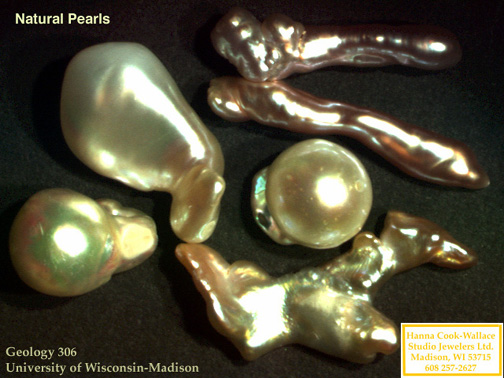
|
|
Pearls
What are pearls? How are cultured pearls different from natural pearls?
Pearls are known to have been used in jewelry for over 6000 years!
PHYSICAL CHARACTERISTICS:
-
hardness: 2.5 - 4.5
-
S.G.: 2.70 (fresh-water up to 2.74)
-
Size: from microscopic to many centimeter diameter (rare)
-
Luster - typical pearly luster is termed "orient"
-
a variety
of colors, depending upon the type of mollusc and the water composition
(polluted water produces unusual colors!)
-
bodycolor: underlying color: white-yellow (cream), black
-
overtone: "float" (resembles a filmy lacquer): pink / green / blue
-
composition:
-
~ 86 % calcium carbonate (CaCO3)
-
2 - 4 % water
-
~ 10 % conchiolin (an organic binding agent)
Together, the conchiolin and CaCO3 are referred to as nacre.
Nacre consists of a series
of alternating layers of conchiolin and crystals of CaCO3. The CaCO3
is in the crystal form known as aragonite. The typical irridescence
of the pearl is due to the series of nacre
layers. This is referred to as 'orient'(iridescent effect due
to overlapping nacreous plates)
Summary: what makes a pearl a pearl?
-
they must have outer nacre (mostly aragonite) layer to be considered a
true pearl
-
thus only pearls from mollusks with a nacreous mother of pearl lining are
"true" pearls
|
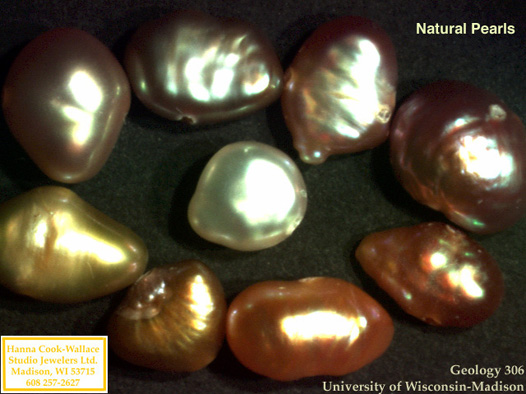
View
some images of pearls and organic gems
History
of culturing of pearls:
Care of
Pearls!
How to
buy pearls
|
Formation
Pearls are produced by a variety of organisms, commonly sea molluscs. They
are also produced by fresh water mussels, and occassionally, by snails.
Some examples of pearl-producing oysters (you don't have to remember these)
are:
-
Akoya pearl oysters (Pinctada fucata)
-
Black Lip Pearl shell (Pinctada margaritifera)
-
Freshwater mussel (Hydriopsis schlegeli)
-
Large winged pearl shell (Pteria penguin)
-
Abalone (Notohaliotis discus)
-
Golden Lip pearl shell or white lip pearl shell (Pinctada maxima)
Reference: Mikimoto Pearl Museum, Toba.
|
|
Natural Pearls:
Concentric layers
of CaCO3 are deposited around an irritant.
This may be a piece of mantle lobe or some other material.
Only the mantle lobe can secrete nacre. When a piece of mantle lobe
is introduced by some accident into the tissue of the oyster, the oyster
forms a bag known as a "pearl sac". It is this sac that secretes the nacre
around the irritant to make the pearl.
Thus, pearls are calcareous concretions
Some natural pearls have quite unusual
shapes. These are often called "baroque" pearls.
Both saltwater and freshwater pearls consist of the same material and
can form in "baroque" shapes. Unless you are quite familiar with the typical
characteristics ("look") of pearls from certain specific sources, it would
be very difficult to know whether a given pearl was saltwater or freshwater
in origin.
Probably the most common freshwater pearl on the market is the Chinese
freshwater baroque, some of which are crinkily and look like crisped rice.
These have been very popular in recent years because they cost dramatically
less than Akoya cultured pearls.
|
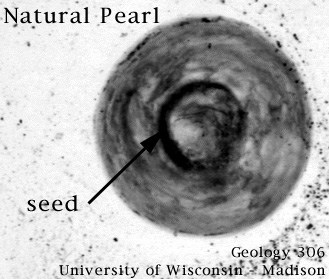
|
Blister Pearls:
Blister
pearls form on the inside
of the mother of pearl shell
|
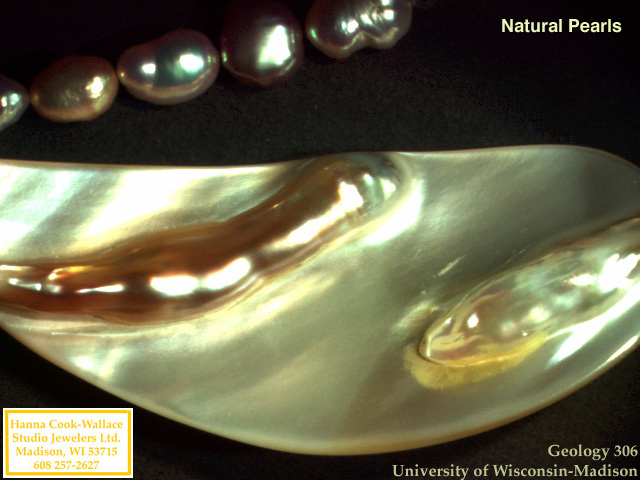 |
Cultured Pearls:
Oysters and mussels are induced to make pearls. The result
are termed "cultured pearls".
Maybe 90% of the pearls sold are cultured
If you break
a pearl open you will see that it consists of a bead covered by a thin
layer of nacre.
The culturing process involves inserting a small piece of mantle lobe
and a bead made from mother of pearl shell into the tissues of a pearl-producing
mollusk.
The mollusk treats the bead as an irritant and the mantle lobe
tissue begins to deposit a nacreous coating over it.
Here is a description and some photographs to illustrate the process.
The photographs were taken at the Mikimoto Pearl Museum, Toba, Japan:
Oysters are raised in a tank, allowed to attach to fibers, then grown in
sea water for two to three years. Growing oysters are suspended in cages
hung from rafts. They feed on plankton. Healthy oysters are selected for
pearl cultivation.
The bead is prepared. Mikimoto use Pig toe clam shells, from the Mississippi
River. Small balls are prepared from pieces of these shells. An example
of a mother
of pearl bead.
Living oysters are wedged open and a piece of mantle lobe harvested from
an other oyster, plus a bead, are inserted into the soft tissue. This image
shows insertion
of mantle tissue and bead. Here is a labelled
version of this image, showing the important components.
This image
shows
the oyster source of mantle tissue, the cut up pieces of mantle tissue,
and the mother of pearl beads. A labelled version of this image is given
here.
Oysters are then returned to the sea, where they are suspended in cages
7 - 10 feet below the surface. They are maintained and harvested after
some time. The culture period used to be ~ 3.5 yrs, producing ~ 1mm layer
on the bead, but now the culture period may take less than 2 yrs.
The commercial production method is now known as the Mise-Nishikawa method
Typical results:
(you do not need to memorize these numbers)
5% high quality pearls (hanadama)
28% marketable pearls
17% unmarketable pearls
5% uncoated nuclei
50% of oysters containing nuclei will die.
Source: Mikimoto.
Selection and presentation of pearls: Pearls are selected for their
size and color
(hue). Careful color grading is extremely important.
Pearls are then drilled from both sides, often at a place that is slightly
flawed. They are then sorted, threated, and marketed.
|
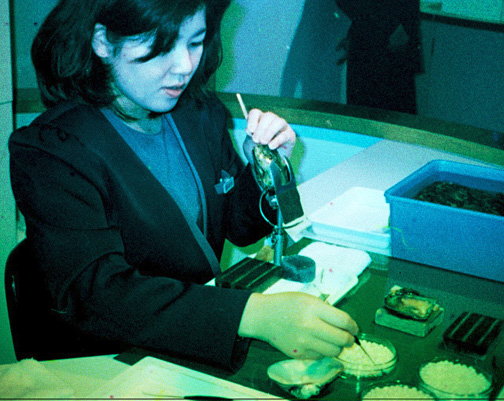
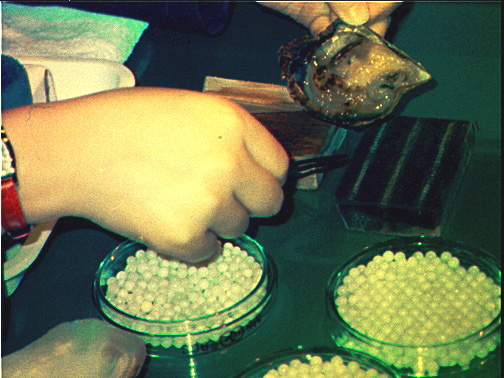
 |
Mabe pearls:
Mabe pearls are cultured blister pearls. These are produced
by inserting a half bead against the shell of the mollusk, after a layer
of nacre has been deposited over the bead, the whole formation is cut out
and the nacreous dome cemented onto a mother of pearl bed.
|
|
Biwa pearls:
Biwa pearls are produced at lake Biwa, Japan using freshwater
clams. They are irregular in shape but have good color and luster. Instead
of a bead a small square of mother of pearl in inserted into the clam.
These pearls require three years to produce good results.
|
|
Natural or Cultured?
Distinction between these can often be made if the pearl is drilled because
the size and nature of the seed can be determined. For cultured pearls,
you should see a mm or so beneath the surface.
The term "candling" refers to examination of pearls in strong light.
This may reveal the mother of pearl bead.
If the pearl is undrilled, an excellent method to distinguish cultured
from natural pearls is to X-ray them.
Because the size of the seed differs, natural pearls ar less dense than
most cultured pearls.
Information
comparing Japanese and Chinese pearls
|
|
Use
The majority are strung as necklaces.
Some are used in rings.
Rejects are used in medicines as a source of calcium. |
|
Preservation and damage
Conchiolin is prone to drying. If this occurs, the pearl becomes dull,
the surface cracks and finally peels.
Pearls are damaged by excess humidty, dryness, acids, perspiration,
cosmetics, hair sprays, and other chemicals.
|
|
Treatments
Pearls can also be dyed
Pearls are sometimes bleached to lighten their color |
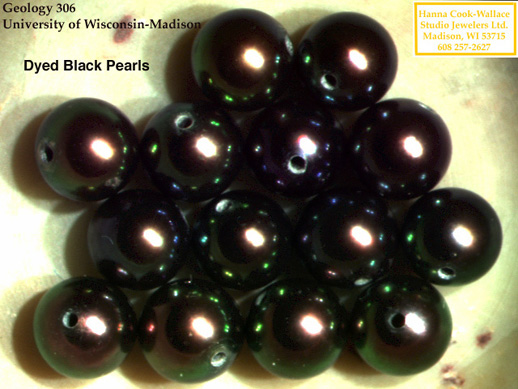 |
Conch "Pearls"
Conch "pearls": because they lack nacre, these are not considered real
pearls. They are often orange or pink in color. They form as concretions
in conch shells.
|
|
Other organic gems
Coral,
amber
(which may include a variety of inclusions
and cracks)
and the tagua
nut, which is used in place of
ivory |
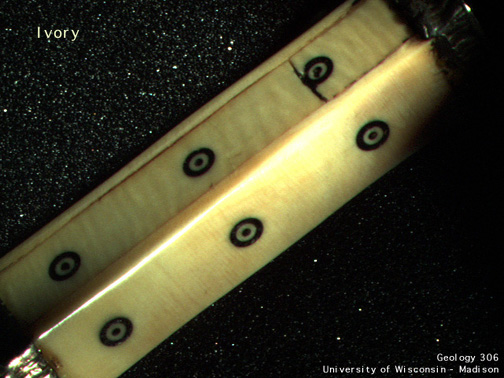 |








